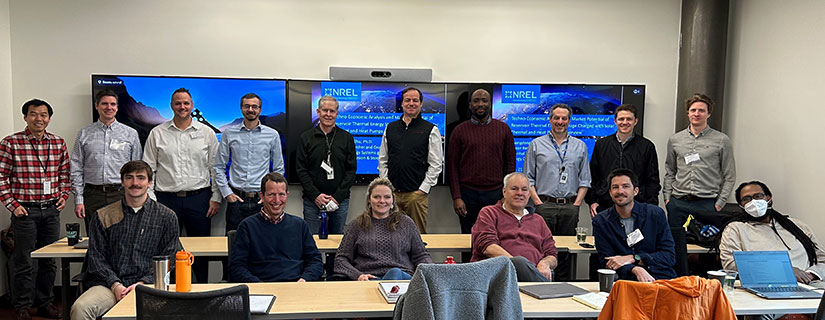NREL-Led Team Explores Potential of Underground Geothermal Energy Storage for All Seasons
Top Researchers From Across the Country Recently Met on NREL's Campus To Kick Off a Partnership Aimed at Developing Geothermal Hybrid Technologies

Renewable energy storage technologies with long-duration capabilities are essential as the U.S. power grid and wider energy economy move toward decarbonization. To meet these needs, researchers are exploring novel means to capture excess energy production.
A new project led by the National Renewable Energy Laboratory (NREL) aims to address the increasing need by tapping into underground geothermal reservoirs. By storing excess energy as thermal energy underground, energy generated at one time can be captured, stored, and recovered for use after many months or even seasons.
This project evaluates the technical and economic opportunities to hybridize concentrating solar power and periods of low-cost renewable electricity with geothermal reservoir thermal energy storage to provide these important storage capabilities at the national level.
"This project will identify suitable sites for geothermal reservoir thermal energy storage, as well as investigate charging the system with thermal energy from two different sources—concentrating solar power and from heat pumps which can be run during periods of low-cost or negatively priced renewable electricity—allowing these systems to be deployed in nontraditional regions," said Guangdong Zhu, project lead and NREL group manager of thermal energy systems.
The recent kickoff meeting for this project brought together 20 participants from partnering entities to NREL's campus. In addition to NREL, partners on the project include the U.S. Department of Energy's Geothermal Technologies Office, Lawrence Berkeley National Laboratory, Idaho National Laboratory, Premier Resource Management, and Earthbridge Energy.
The national laboratories will work with Premier Resource Management on a case study to explore using legacy oil/gas reservoirs with solar thermal hybridization in California. They will also work with Earthbridge Energy on a case study to apply high-efficiency heat pump technologies to store excess wind power into water reservoirs in Texas.
"This project will also evaluate opportunities to reduce RTES (reservoir thermal energy storage) development costs, by leveraging already existing infrastructure and using, for example, depleted oil and gas reservoirs," said Jerry Carr, project officer at the U.S. Department of Energy's Geothermal Technologies Office.
While thermal storage in shallow aquifers has been successfully implemented in the United States and western Europe for decades, there are currently no commercial thermal storage projects in depleted oil and gas reservoirs. Not only will utilizing this resource promote significant cost savings, but it will also encourage oil and gas industries to participate in the transition to a decarbonized energy economy by leveraging existing capital and assets.
Stored thermal energy has the potential to generate electricity and directly produce heat that can be used by industrial processes. The energy can also be kept in cold storage reservoirs to be used for building and industrial cooling.
Demonstrating the economic possibilities of stored thermal heating and cooling may promote wide-scale deployment of these systems. This will allow consumers to benefit from lower costs, improving accessibility in all communities.
This article has been updated to reflect an editorial change made after its original publication.
Last Updated May 28, 2025
